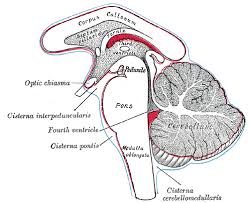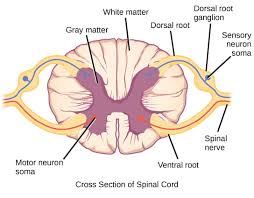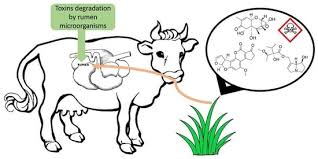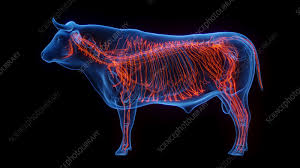The nervous system coordinates voluntary and involuntary actions and transmits signals to and from different parts of the body. It detects and responds to changes both internally and externally.
Along with the endocrine system, the nervous system controls vital functions and maintains homeostasis. Its response is much faster than that of the endocrine system.
Read Also: 9 Ways to Fatten Up your Pigs the Right Way
Components of the Nervous System

The nervous system in farm animals is essential for coordinating body activities and responding to internal and external stimuli. It consists of two major components:
1. Central Nervous System (CNS): The CNS includes the brain and spinal cord. The brain serves as the control center, processing information and sending signals throughout the body. The spinal cord acts as a communication link between the brain and the rest of the body, transmitting signals to and from the brain.
2. Peripheral Nervous System (PNS): The PNS consists of all the nerves that branch out from the brain and spinal cord, extending to various parts of the body. It is divided into two subcomponents:
i. Somatic Nervous System: Controls voluntary movements by transmitting signals from the CNS to skeletal muscles.
ii. Autonomic Nervous System: Regulates involuntary functions such as heart rate, digestion, and respiration. It is further divided into:
a. Sympathetic Nervous System: Prepares the body for stressful or emergency situations (fight-or-flight response).
b. Parasympathetic Nervous System: Helps the body to relax and maintain normal body functions during restful states (rest-and-digest response).
These components work together to ensure proper communication and coordination within the body, facilitating movement, perception, and vital functions.
Functions of the Autonomic Nervous System
The autonomic nervous system (ANS) controls involuntary bodily functions that are crucial for the regulation of internal organs and the maintenance of homeostasis in farm animals. Its main functions include:
1. Regulating Heart Rate: The ANS adjusts the heart rate to meet the body’s demands, either increasing it during stressful situations (sympathetic) or slowing it down during rest (parasympathetic).
2. Controlling Digestive Processes: It regulates the contraction and relaxation of smooth muscles in the digestive tract, influencing digestion and nutrient absorption.
3. Managing Respiratory Function: The ANS controls the rate and depth of breathing, adjusting airflow in response to oxygen demands.
4. Regulating Glandular Secretions: The ANS influences the secretion of hormones and enzymes, such as saliva and digestive juices, essential for metabolism.
5. Controlling Blood Vessel Constriction/Dilation: It adjusts blood flow by regulating the constriction and dilation of blood vessels to maintain blood pressure and ensure proper circulation.
Read Also: The Different Crop Storage Methods
Effects of Autonomic Stimulation

Autonomic stimulation has distinct effects depending on whether the sympathetic or parasympathetic division is activated:
1. Sympathetic Stimulation
i. Increased Heart Rate and Force of Contraction: Prepares the animal for increased physical activity.
ii. Dilation of Bronchioles: Allows more air to enter the lungs for oxygen exchange.
iii. Inhibition of Digestive Activity: Slows down digestion to divert energy towards essential activities during stress or danger.
iv. Pupil Dilation: Enhances vision by allowing more light to enter the eyes.
2. Parasympathetic Stimulation
i. Decreased Heart Rate: Promotes relaxation and conserves energy.
ii. Increased Digestive Activity: Enhances digestion by stimulating gut motility and secretion of digestive enzymes.
iii. Constriction of Bronchioles: Reduces airflow as oxygen demands decrease.
iv. Pupil Constriction: Adjusts the eyes for close vision and rest.
Afferent Impulses from Viscera
Afferent impulses from the viscera refer to sensory signals that are transmitted from the internal organs (viscera) to the central nervous system. These impulses provide information about the state of the organs, such as stretch, pressure, and chemical changes.
In farm animals, afferent impulses help regulate processes like hunger, thirst, pain, and the need for voiding wastes. The CNS interprets these signals and triggers the appropriate autonomic responses, maintaining organ function and overall body balance.
Response of Nervous Tissue to Injury
Nervous tissue, which includes neurons and neuroglia, plays a vital role in transmitting and processing signals throughout the body. When nervous tissue is injured, the body initiates various responses to repair or limit damage, though the ability to recover depends on the extent and location of the injury.
1. Neuron Damage
Neurons are highly specialized cells responsible for transmitting electrical impulses within the nervous system. When neurons are damaged due to trauma, disease, or ischemia (lack of blood flow), they often have a limited ability to repair themselves because mature neurons do not readily divide or regenerate.
i. Disruption of Function: Damage to neurons can result in the loss of sensory, motor, or cognitive functions, depending on the affected area. In farm animals, this could lead to impaired coordination, paralysis, or reduced responsiveness to stimuli.
ii. Cell Death: Severe injury can cause neuron death, leading to irreversible loss of function in the affected region. In such cases, compensatory mechanisms, like neural plasticity, attempt to reroute signals through surviving neurons.
2. Neuron Regeneration
In the central nervous system (CNS), which includes the brain and spinal cord, neurons have very limited regenerative ability due to the inhibitory environment and the presence of glial scars, which impede repair. However, in the peripheral nervous system (PNS), neuron regeneration is possible under certain conditions:
i. Axon Regrowth in the PNS: If the cell body of a damaged neuron in the PNS remains intact, the axon (the long extension of the neuron) can regenerate. Schwann cells, a type of glial cell, play a key role in guiding the regrowth of the axon toward its target.
ii. Limited Regeneration in CNS: In contrast, neurons in the CNS show poor regenerative capacity due to inhibitory factors released by oligodendrocytes and astrocytes. This lack of regeneration can result in permanent disabilities, such as motor or sensory impairments in farm animals.
3. Neuroglia Damage
Neuroglia, or glial cells, are the supportive cells of the nervous system that protect, nourish, and insulate neurons. There are several types of glial cells, and their responses to injury vary:
i. Astrocyte Damage: Astrocytes play a critical role in maintaining the blood-brain barrier and providing nutrients to neurons. When damaged, astrocytes can become reactive, leading to the formation of glial scars. These scars help prevent further damage but also inhibit neuron regeneration, particularly in the CNS.
ii. Oligodendrocyte Damage: Oligodendrocytes are responsible for producing myelin, which insulates axons and ensures efficient signal transmission. Damage to oligodendrocytes results in demyelination, slowing down nerve signal conduction. In conditions like multiple sclerosis, the loss of myelin severely impairs nervous system function.
iii. Schwann Cell Damage: In the PNS, Schwann cells support axon regeneration by promoting remyelination and guiding regrowth. Damage to Schwann cells hampers the regeneration process, delaying or preventing full recovery of nerve function.
Effects of Poisons on the Central Nervous System

1. Disruption of Neurotransmission: Poisons can interfere with the transmission of nerve signals by blocking or mimicking neurotransmitters, leading to issues like paralysis or uncontrollable muscle contractions.
2. Respiratory Failure: Certain poisons impair the brain’s ability to regulate breathing, which can result in breathing difficulties or complete respiratory arrest.
3. Seizures: Many poisons overstimulate the nervous system, causing uncontrolled electrical activity in the brain, leading to convulsions and seizures.
4. Loss of Motor Control: Some toxins damage the parts of the brain responsible for movement, resulting in tremors, lack of coordination, or even complete loss of voluntary muscle control.
5. Cognitive Impairment: Poisons that target brain cells can cause memory loss, confusion, and impaired judgment, affecting overall cognitive function.
6. Coma: Prolonged exposure to certain neurotoxic substances can lead to severe brain damage, resulting in a coma, where the affected person is unresponsive.
7. Sensory Disturbances: Poisons can also affect sensory nerves, leading to problems like blindness, deafness, or loss of sensation in various parts of the body.
Infections of the Central Nervous System
1. Meningitis: This is the inflammation of the protective membranes covering the brain and spinal cord, caused by bacterial, viral, or fungal infections. It can result in severe headaches, fever, neck stiffness, and if untreated, brain damage or death.
2. Encephalitis: This is the inflammation of the brain itself, often caused by viral infections. Symptoms include fever, headache, confusion, seizures, and in severe cases, coma or death.
3. Brain Abscess: A localized collection of pus in the brain tissue due to bacterial or fungal infection. It can cause headaches, fever, neurological deficits, and in some cases, seizures.
4. Spinal Cord Infections: Infections such as spinal epidural abscess or spinal meningitis can lead to severe back pain, fever, and neurological symptoms like paralysis or loss of bladder control.
5. Neurocysticercosis: This is caused by the larval stage of the pork tapeworm infecting the brain. It can cause seizures, headaches, and other neurological symptoms due to the formation of cysts in the central nervous system.
6. HIV-associated Neurocognitive Disorders (HAND): Infections like HIV can lead to inflammation and damage in the brain, resulting in memory loss, difficulty concentrating, mood changes, and impaired motor function.
7. Rabies: This viral infection affects the brain, leading to symptoms like fever, confusion, hallucinations, and paralysis, and is nearly always fatal once symptoms appear.
Do you have any questions, suggestions, or contributions? If so, please feel free to use the comment box below to share your thoughts. We also encourage you to kindly share this information with others who might benefit from it. Since we can’t reach everyone at once, we truly appreciate your help in spreading the word. Thank you so much for your support and for sharing!

